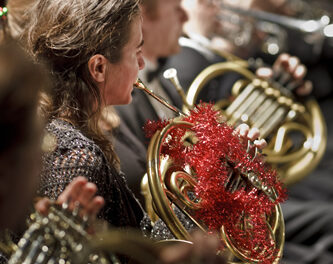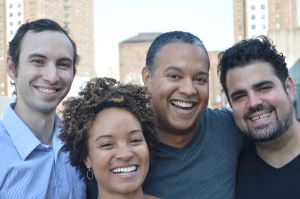If you have not yet been out to the Koka Booth Amphitheatre of the Town of Cary, you may not yet know that this is the beautifully presented Carolina equivalent to Tanglewood, the summer home of the Boston Symphony Orchestra, where music lovers may bring their own chairs, tables, and picnic accouterments, and enjoy listening to the classics under the sky and stars, with ample free parking. Some person or persons in Cary deserve considerable credit for creating this facility, with a very attractive music shed, inclined lawn, and various vendors for food and drink. My only criticism would be that the vendors, now that we are in the twenty-first century, should accept plastic, rather than the cash-only policy that obtains at present. The civic theme was very much present in the publicity that announced that the players of the NCS would be joined by “citizen” musicians, as part of the “Play with the Pros” program. The citizens were identifiable by their white chairs – almost fifty players, divided evenly between strings, and winds and percussion. The augmented group was heard for the three works on the first half of the program.
Given that we are still in May, it was perhaps not surprising that the orchestra was joined in the music shed by about ten open-flame gas heaters, producing the effect of a Polynesian restaurant, in Maestro William Henry Curry’s words, or perhaps some Masonic festivity. The program opened with an appealing work from that part of French music history which is a virtual black hole, despite the fact that the music from this period was successful worldwide. This was the overture from the opera Zampa, by Ferdinand Hérold, originally premiered in 1831, and radically different in style from the seriousness of the Germans of the day, with brilliant and virtuoso writing for the strings, as well as surprising moments from the brass. (I imagine that the arrangement credited to Aubrey Winter was simply a matter of modernizing the scoring, which originally called for obsolete instruments like C-clarinets and ophicleide.) Apart from a few sloppy off-beats in the woodwinds, the ensemble was very stylish under Curry’s baton. I can imagine that many listeners would love to hear more works from this period.
Next up was the English Folk Song Suite by Ralph Vaughan Williams, arranged by Gordon Jacob from an original for military band, full of memorable folk tunes, and beautifully rendered, with a fine oboe solo in the slow movement (“My Bonny Boy”). Closing the half was the famous Finlandia by Jean Sibelius, which suffered in this context. The amplification tended, throughout, to give an unnatural boost to the bass frequencies, and this, combined with the augmented ensemble, made Finlandia sound very heavy, ponderous, overly thick, and while the famous melody rang out at the work’s conclusion, the whole effect made one wonder if Sibelius really deserves to belong to the composing elite.
The NCS, without guests, returned for the Brahms Symphony No. 2, one of the lighter works by a master who tends to length and weight. After the opening Allegro, Curry announced that due to the cool temperatures (62 degrees by the conclusion of the concert), and even with the heaters, the NCS would omit the Adagio, and proceed directly to the concluding Allegretto and Allegro, so that the result was even lighter than usual, and the final movement went at a great clip, so much so that the famous off-beats barely told, but it made for an exhilarating close.
Sixty-two degrees is hardly extreme for an outdoor performance, and one could imagine complaints that the NCS was charging regular prices for a concert that provided barely longer than an hour of music (with a fifteen-minute intermission, and starting late, the evening was done by 8:50). On the other hand, a major part of the evening is the “tailgating” prior to the concert, so perhaps cool Carolinians were just as happy to get out of the weather.












